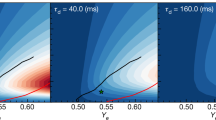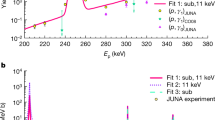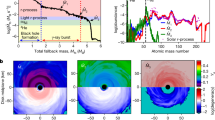Abstract
In the centres of stars where the temperature is high enough, three α-particles (helium nuclei) are able to combine to form 12C because of a resonant reaction leading to a nuclear excited state1. (Stars with masses greater than ∼0.5 times that of the Sun will at some point in their lives have a central temperature high enough for this reaction to proceed.) Although the reaction rate is of critical significance for determining elemental abundances in the Universe1, and for determining the size of the iron core of a star just before it goes supernova2, it has hitherto been insufficiently determined2. Here we report a measurement of the inverse process, where a 12C nucleus decays to three α-particles. We find a dominant resonance at an energy of ∼11 MeV, but do not confirm the presence of a resonance at 9.1 MeV (ref. 3). We show that interference between two resonances has important effects on our measured spectrum. Using these data, we calculate the triple-α rate for temperatures from 107 K to 1010 K and find significant deviations from the standard rates3. Our rate below ∼5 × 107 K is higher than the previous standard, implying that the critical amounts of carbon that catalysed hydrogen burning in the first stars are produced twice as fast as previously believed4. At temperatures above 109 K, our rate is much less, which modifies predicted nucleosynthesis in supernovae5,6.
This is a preview of subscription content, access via your institution
Access options
Subscribe to this journal
Receive 51 print issues and online access
$199.00 per year
only $3.90 per issue
Buy this article
- Purchase on Springer Link
- Instant access to full article PDF
Prices may be subject to local taxes which are calculated during checkout



Similar content being viewed by others
References
Wallerstein, G. et al. Synthesis of the elements in stars: 40 years of progress. Rev. Mod. Phys. 69, 995–1084 (1997)
Austin, S. in Proc. 8th Nuclei in the Cosmos Conf., Nucl. Phys. A (in the press)
Angulo, C. et al. A compilation of charged-particle induced thermonuclear reaction rates. Nucl. Phys. A 656, 3–183 (1999)
Siess, L., Livio, M. & Lattanzio, J. Structure, evolution, and nucleosynthesis of primordial stars. Astrophys. J. 570, 329–343 (2002)
Fröhlich, C. et al. Composition of the innermost supernova ejecta. Astrophys. J. (submitted)
Pruet, J., Woosley, S. E., Buras, R., Janka, H.-T. & Hofmann, R. D. Nucleosynthesis in the hot convective bubble in core-collapse supernovae. Astrophys. J. (submitted)
Ajzenberg-Selove, F. Energy levels of light nuclei A = 11–12. Nucl. Phys. A 506, 1–158 (1990)
Hoyle, F., Dunbar, D. N. F., Wenzel, W. A. & Whaling, W. A state in 12C predicted from astrophysical evidence. Phys. Rev. 92, 1095 (1953)
Dunbar, D. N. F., Pixley, R. E., Wenzel, W. A. & Whaling, W. The 7.68 MeV state in 12C. Phys. Rev. 92, 649–650 (1953)
Cook, C. W., Fowler, W. A., Lauritsen, C. C. & Lauritsen, T. B12, C12, and the red giants. Phys. Rev. 107, 508–515 (1957)
Morinaga, H. Interpretation of some of the excited states of 4n self-conjugate nuclei. Phys. Rev. 101, 254–258 (1956)
Cook, C. W., Fowler, W. A., Lauritsen, C. C. & Lauritsen, T. High energy alpha particles from B12 . Phys. Rev. 111, 567–571 (1958)
Fynbo, H. O. U. et al. Clarification of the three-body decay of 12C(12.71 MeV). Phys. Rev. Lett. 91, 082502 (2003)
Lane, A. M. & Thomas, R. G. R-matrix theory of nuclear reactions. Rev. Mod. Phys. 30, 257–353 (1958)
John, B., Tokimoto, Y., Lui, Y.-W., Clark, H. L., Chen, X. & Youngblood, D. H. Isoscalar electric multipole strength in 12C. Phys. Rev. C 68, 014305 (2003)
Itoh, M. et al. Study of the cluster state at Ex = 10.3 MeV in 12C. Nucl. Phys. A 738, 268–272 (2004)
Fowler, W. A. Experimental and theoretical nuclear astrophysics: The quest for the origin of the elements. Rev. Mod. Phys. 56, 149–179 (1984)
Weaver, T. A. & Woosley, S. E. Nucleosynthesis in massive stars and the 12C(α,γ)16O reaction rate. Phys. Rep. 227, 65–96 (1993)
Schlattl, H., Heger, A., Oberhummer, H., Rauscher, T. & Csótó, A. Sensitivity of the C and O production on the 3α rate. Astrophys. Space Sci. 291, 27–56 (2004)
Delano, M. D. & Cameron, A. G. W. Nucleosynthesis in neutron rich supernova ejecta. Astrophys. Space Sci. 10, 203–226 (1971)
Schatz, H. et al. Rp-process nucleosynthesis at extreme temperature and density conditions. Phys. Rep. 294, 167–263 (1998)
Woosley, S. E. et al. Models for Type I X-ray bursts with improved nuclear physics. Astrophys. J. Supp. 151, 75–102 (2004)
Käppeler, F., Thielemann, F.-K. & Wiescher, M. Current quests in nuclear astrophysics and experimental approaches. Annu. Rev. Part. Sci. 48, 175–251 (1998)
Herwig, F. & Austin, S. M. Nuclear reaction rates and carbon star formation. Astrophys. J. 613, L73–L76 (2004)
Äystö, J. Development and applications of the IGISOL technique. Nucl. Phys. A 693, 477–494 (2001)
Kugler, E. The ISOLDE facility. Hyperfine Interact. 129, 23–42 (2000)
Bergmann, U. C., Fynbo, H. O. U. & Tengblad, O. Use of Si strip detectors for low-energy particles in compact geometry. Nucl. Instrum. Methods A 515, 657–664 (2003)
Tengblad, O., Bergmann, U. C., Fraile, L. M., Fynbo, H. O. U. & Walsh, S. Novel thin window design for a large-area silicon strip detector. Nucl. Instrum. Methods A 525, 458–464 (2004)
Barker, F. C. & Warburton, E. K. The beta-decay of 8He. Nucl. Phys. A 487, 269–278 (1988)
Schwalm, D. & Povh, B. Alpha particles following the β-decay of 12B and 12N. Nucl. Phys. 89, 401–411 (1966)
Acknowledgements
This research was supported by the Academy of Finland under the Finnish Centre of Excellence Programme, by the Spanish Agency CICYT, and by the European Union Fifth Framework Programme ‘Improving Human Potential—Access to Research Infrastructure’. Discussions with J. Christensen-Dalsgaard and C. Fröhlich are acknowledged.
Author information
Authors and Affiliations
Corresponding author
Ethics declarations
Competing interests
The authors declare that they have no competing financial interests.
Rights and permissions
About this article
Cite this article
Fynbo, H., Diget, C., Bergmann, U. et al. Revised rates for the stellar triple-α process from measurement of 12C nuclear resonances. Nature 433, 136–139 (2005). https://doi.org/10.1038/nature03219
Received:
Accepted:
Issue Date:
DOI: https://doi.org/10.1038/nature03219
This article is cited by
-
α-Clustering in atomic nuclei from first principles with statistical learning and the Hoyle state character
Nature Communications (2022)
-
Correlation between the behavior of α-decay half-lives and the energy levels of parent nuclei as supply of α nucleons
Indian Journal of Physics (2022)
-
Enhanced triple-α reaction reduces proton-rich nucleosynthesis in supernovae
Nature (2020)
-
Network structure of thermonuclear reactions in nuclear landscape
Science China Physics, Mechanics & Astronomy (2020)
-
Current Status of Nuclear Physics Research
Brazilian Journal of Physics (2015)
Comments
By submitting a comment you agree to abide by our Terms and Community Guidelines. If you find something abusive or that does not comply with our terms or guidelines please flag it as inappropriate.



